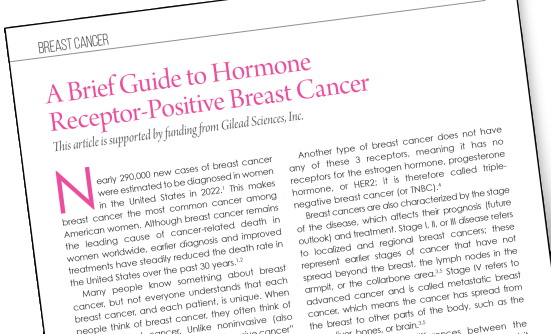When someone is diagnosed with breast cancer, a sample of the tumor is tested for biomarkers, also called prognostic factors, to determine if the cancer cells have certain receptors. These receptors will determine the type of breast cancer and the best type of treatment.
Biomarker/prognostic factor testing in breast cancer includes the following:
Estrogen receptor (ER): If the breast cancer cells have ERs, the cancer is called ER positive (ER+). Conversely, if the breast cancer cells do not have ERs, the cancer is called ER negative (ER–).
Progesterone receptor (PR): If the breast cancer cells have PRs, the cancer is called PR positive (PR+). Conversely, if the breast cancer cells do not have PRs, the cancer is called PR negative (PR–).
Human epidermal growth factor receptor type 2 (HER2/neu or HER2): If the breast cancer cells have larger than normal amounts of HER2 on their surface, the cancer is called HER2 positive (HER2+). If the breast cancer cells have a normal amount of HER2 on their surface, the cancer is called HER2 negative (HER2–).
If the breast cancer cells do not have any of the above-mentioned biomarkers (meaning, the cancer cells are ER–, PR–, and HER2–), the cancer is called triple negative. By the same token, if the cancer cells are positive for all 3 markers (ER+, PR+, HER2+), the cancer is called triple positive. In this article, we will look specifically at HR+ breast cancer.
Hormones and Cancer
Hormones are substances made by glands in the body and circulated in the bloodstream. Some hormones can cause certain cancers to grow. If the cancer cells have places where hormones can attach (receptors), as we discussed above, then medicines, surgery, or radiation therapy can be used to reduce the production of hormones and/or block them from attaching to the cancer cells. For example, the hormone estrogen, which makes some breast cancers grow, is made mainly by the ovaries. Treatment to stop the ovaries from making estrogen is called ovarian ablation.
If you have gone through menopause naturally or have had your ovaries surgically removed, you might assume that your body no longer produces estrogen. This simply is not true. Estrogen is stored in body fat and continues to be produced in your adrenal glands even after menopause.
Estrogen and progesterone are hormones, so you may also hear ER+ and PR+ cancer called simply hormone-positive cancer, or HR+.
Hormone-Positive Breast Cancer
Some breast cancers have receptors that attach to the hormones estrogen and progesterone. These hormones cause ER+ and PR+ breast cancer cells to grow and divide. To check for ERs and PRs, samples of tissue containing the breast cancer cells are removed during a breast biopsy and tested in a laboratory. Sometimes, if the biopsy sample is too small, this test can be performed at the time of the breast cancer surgery (lumpectomy or mastectomy).
HR+ cancer (both ER+ and PR+) may grow more quickly than other cancers; however, it is considered a very favorable prognostic factor because there are drugs that can control hormones and block them from stimulating the growth of cancer cells. In essence, the test results show whether treatment to block estrogen and progesterone may stop the cancer from growing.
Degree of Positivity
Ideally, a pathologist will provide more detail about the degree of positivity of the breast cancer cells. This information is helpful when considering treatment options. Many times, the pathologist will provide the degree of positivity as a percentage. For example, perhaps 90% of the cancer cells have ERs. Or perhaps only 10% of the cells have receptors. Although both percentages represent ER+ breast cancer, the higher the positivity rate the more favorable the prognostic factor. Logically, this makes sense: if only 10% of the tumor cells have the receptors, and the treatment is designed to block these receptors, then the impact of the treatment may be less effective in this case when you compare it with a case where the cancer has a 90% positivity rate.
Hormone Receptor Status in Metastatic Breast Cancer
It is possible that the hormone receptor status can change if you have stage IV, or metastatic, breast cancer (meaning that the cancer has traveled beyond the breast to other organs in the body). In approximately 20% of metastatic breast cancer cases, a previously diagnosed HR+ cancer may no longer have ERs and PRs. Instead of relying on the original pathology testing, it is important for women with metastatic breast cancer to have a new biopsy completed from one of the organs where the cancer has spread. In fact, it is important to retest for all 3 biomarkers: ERs, PRs, and HER2. This will provide you and your doctor with the necessary information to make the best treatment choice for you.
Predicting the Risk of Recurrence in HR+ Breast Cancer
There are genomic tests available that analyze the genes in the cancer. These tests may help predict whether the cancer will come back (recur) or spread to other parts of the body. To perform this type of test, the pathologist will send a breast cancer tissue sample to a company that specializes in genomic evaluation. The following genomic tests have been studied in clinical trials and are part of today’s standard of care:
Oncotype DX: This test helps predict whether early-stage breast cancer that is ER+ will spread to other parts of the body as well as the likely benefit of chemotherapy. If the risk that the cancer will return or spread is high, chemotherapy may be given to lower the risk.
MammaPrint: This test looks at the activity of 70 different genes in the breast cancer tissue of women who have early-stage, invasive breast cancer that has not spread to lymph nodes or has spread to 3 or fewer lymph nodes. The activity level of these genes helps predict whether the breast cancer will come back or spread to other parts of the body. If the test shows a high likelihood that the cancer will spread or come back, chemotherapy may be given to lower that risk.
Hormonal Therapy
First, I’d like to make an important distinction: hormonal therapy for breast cancer is not hormone replacement therapy (HRT). If you are taking HRT when diagnosed, your doctor will instruct you to stop taking it immediately. In fact, most oncologists recommend discontinuing this type of medication regardless of the hormone receptor status (positive or negative). For women diagnosed with HR+ breast cancer, stopping HRT is really the first step of actively treating the disease by removing a primary source of hormones that “feed” the cancer cells and cause them to grow.
Now, let’s talk about hormonal therapy for breast cancer. Hormonal therapy is a cancer treatment that removes hormones or blocks their action and stops cancer cells from growing. In women with HR+ breast cancer, at least 5 years of adjuvant hormonal therapy reduces the risk that the cancer will come back. There are several types of hormonal therapies:
Tamoxifen
Hormonal therapy with tamoxifen is often given to patients with early localized breast cancer that can be removed by surgery and to those with metastatic breast cancer. Women taking tamoxifen should have a pelvic exam every year to look for any signs of cancer. Although small, women taking tamoxifen have about a 1% risk of developing endometrial cancer. Any vaginal bleeding, other than menstrual bleeding, should be reported to a doctor as soon as possible.
Luteinizing Hormone-Releasing Hormone
Hormonal therapy with a luteinizing hormone-releasing hormone (LHRH) agonist is given to some premenopausal women who have been diagnosed with HR+ breast cancer. LHRH agonists decrease the body’s levels of estrogen and progesterone.
Aromatase Inhibitors
Hormonal therapy with an aromatase inhibitor is given to some postmenopausal women who have HR+ breast cancer. Aromatase inhibitors decrease the body’s estrogen by preventing an enzyme called aromatase from turning androgen into estrogen. Anastrozole, letrozole, and exemestane are types of aromatase inhibitors.
For the treatment of early localized breast cancer that can be removed by surgery, certain aromatase inhibitors may be used as adjuvant therapy instead of tamoxifen, or they may be introduced after 2 to 3 years of tamoxifen use.
For the treatment of metastatic breast cancer, aromatase inhibitors are currently being tested in clinical trials to compare them with hormone therapy with tamoxifen.
Endocrine Therapy
Other types of hormone therapy include antiestrogen therapy such as fulvestrant. This can be given to postmenopausal women with ER+ advanced breast cancer.
Cyclin-Dependent Kinase Inhibitors
This treatment blocks proteins called cyclin-dependent kinases (CDKs), which cause the growth of cancer cells. Combining CDK4/6 inhibitors with hormone therapy may be effective in treating advanced HR+, HER2– breast cancer.
Better Prognoses for Metastatic Breast Cancer
For people living with stage IV metastatic breast cancer that is ER+ and HER2–, tremendous progress has been made in the past decade, enabling them to live far longer than ever before. They are receiving drug combinations such as the ones mentioned immediately above. Many times, they have the ability to take their treatments orally at home while successfully managing side effects, which allows them to continue living their life for as long as a decade or more. This is particularly true for patients whose disease has minimally spread elsewhere, such as to just the bones.
Side Effects
There is no hormonal therapy that is totally free of side effects. Common side effects of hormonal therapies are hot flashes, night sweats, mood swings, low libido, vaginal dryness, and joint pain. There are some measures you can take to help prevent these side effects, such as wearing layered cotton clothing for example, sleeping on a special pillow that keeps your head and neck cool (such as a Chillow pillow), avoiding spicy food and hot beverages, using a vaginal moisturizer daily and a vaginal lubricant during sexual intercourse. However, if you experience any of these side effects, please inform your medical oncologist so that additional measures can be taken to reduce or minimize their impact on your quality of life. When severe, the doctor can prescribe medications to ease side effects. What is most important is for you to continue taking the hormonal therapy as prescribed.
Final Thoughts
The presence of hormone receptors on breast cancer cells is a favorable prognostic factor for people living with breast cancer. This type of cancer can be treated with hormonal therapies that are proved to be quite effective in blocking the effects of estrogen and progesterone in the growth of cancer cells.
I commend you for learning about this type of cancer and hope that this knowledge empowers you to make confident treatment choices. Knowledge is power. And I hope you are discovering that you are very powerful.













